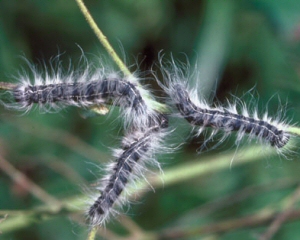Walnut Caterpillars

Walnut caterpillars feed only on the foliage of trees in the Juglandaceae family, including walnuts, pecans, and hickory trees. In large numbers, these caterpillars can defoliate large trees and severely affect tree vigor. The larvae feed in groups or clusters, consuming all the leaves on a single branch before moving to another. Depending on the weather, there can be one to two lifecycles per year. The second lifecycle caterpillars overwinter as pupa to hatch in the spring and lay eggs as adults.
The round eggs are white and loosely laid in groups on the underside of the host plant leaves. Young larvae are yellowish-green and ¼-inch long. The larvae turn dark red and almost black with white hairs as they mature. At the final larval stages, they can be two inches long. A larval shed resembling a hairball can be seen on the trunks. The caterpillars feed for approximately one month before reaching maturity. When disturbed, the caterpillars arch their head and end of the abdomen to ward off predators.
Adult walnut caterpillar moths have approximately a 1 ¾” wingspan, and the wings are light brown with four narrow brown bands on each front wing. The primary effective means of dealing with infestations of walnut caterpillars are to hand-pick caterpillars and place them in a container of soapy water, use a forceful water spray to quickly dislodge caterpillars, or apply insecticides with one of the following active ingredients: acephate, spinosad, malathion, cyfluthrin, permethrin, or bifenthrin.

Have questions? Contact our office where our Horticulture Extension Agent will assist you with questions.
Phone: (316) 321-9660
Email: callae@ksu.edu